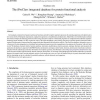NAR
2000
14 years 6 days ago
2000
The Database of Interacting Proteins (DIP; http:// dip.doe-mbi.ucla.edu) is a database that documents experimentally determined protein
NAR
2000
14 years 6 days ago
2000
The ASTRAL compendium provides several databases and tools to aid in the analysis of protein structures, particularly through the use of their sequences. The SPACI scores included...
JCB
2000
14 years 6 days ago
2000
We present a novel method for predicting the secondary structure of a protein from its amino acid sequence. Most existing methods predict each position in turn based on a local wi...
JCB
2000
14 years 6 days ago
2000
A new method for detecting remote protein homologies is introduced and shown to perform well in classifying protein domains by SCOP superfamily. The method is a variant of support...
JCB
2000
14 years 6 days ago
2000
Multiple sequence alignments (MSAs) are frequently used in the study of families of protein sequences or DNA/RNA sequences. They are a fundamental tool for the understanding of th...
BMCBI
2002
14 years 8 days ago
2002
Background: For effective exposition of biological information, especially with regard to analysis of large-scale data types, researchers need immediate access to multiple categor...
CANDC
2004
ACM
14 years 8 days ago
2004
ACM
Gene and protein names follow few, if any, true naming conventions and are subject to great variation in different occurrences of the same name. This gives rise to two important p...
CANDC
2004
ACM
14 years 8 days ago
2004
ACM
Increasingly, scientists have begun to tackle gene functions and other complex regulatory processes by studying organisms at the global scales for various levels of biological org...
CANDC
2004
ACM
14 years 8 days ago
2004
ACM
The exponential growth of large-scale molecular sequence data and of the PubMed scientific literature has prompted active research in biological literature mining and information ...
BMCBI
2004
14 years 9 days ago
2004
Background: The wealth of information on protein structure has led to a variety of statistical analyses of the role played by individual amino acid types in the protein fold. In p...


